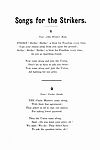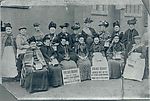 Mary Macarthur rallying the crowd in Cradley Heath
Mary Macarthur rallying the crowd in Cradley Heath A crowded meeting, Express and Star 23.8.1910
A crowded meeting, Express and Star 23.8.1910 Workers withdraw signatures, Daily News 25.8.1910
Workers withdraw signatures, Daily News 25.8.1910 Slaves of the Forge, Daily Express, 1.9.1910
Slaves of the Forge, Daily Express, 1.9.1910 Confident of success, Express and Star, 27.8.1910
Confident of success, Express and Star, 27.8.1910 Women on strike, Midland Evening News 31.8.1910
Women on strike, Midland Evening News 31.8.1910 They sang as they marched
They sang as they marched England's Disgrace
England's Disgrace Meeting outside the Empire Theatre
Meeting outside the Empire Theatre Leaving the Empire Theatre carrying free loaves of bread
Leaving the Empire Theatre carrying free loaves of bread

The women chainmakers went on strike for what they were legally entitled to, the rate set by the Chain Trade Board. Some manufacturers paid the rate as soon as it came into force, but many did not, and tried to trick or force the women into signing forms to contract out of the new minimum wage. Mary Macarthur, Julia Varley, Thomas and Charles Sitch were instrumental in making the women aware of their rights, and organising a strike that was to have significance far beyond Cradley Heath.
Organising a strike was no easy matter. The workshops in which the women worked were scattered across the area. Julia Varley wrote of those times, “We went into the forges, talking to the women as they hammered away, awakening their consciousness to their responsibilities, appealing to their pride and their motherhood.”
Fewer than half the women were in a trade union. In 1907 Thomas Sitch, secretary of the male factory workers’ Chainmakers’ and Strikers’ Association, had worked in close collaboration with Mary Macarthur to organise the women chainmakers. They had met with some success, but many remained outside the union. The subscription of 3d (1.5p) per week could buy a loaf of bread, and a loaf short in a week meant less for each child, or a missed meal.
Once roused by the speeches of Mary Macarthur, however, the women claimed that they would rather drop dead than sign contracting-out forms. The task then was to bring the plight of the women chainmakers to the attention of the nation, in order to put pressure on the manufacturers, and raise money to support the strikers, in particular those women who were not in the union and, therefore, not entitled to payment from the union’s strike fund. Mary Macarthur, supported by the National Federation of Women Workers, The Women’s Trade Union League and the Anti-Sweating League, travelled around the country compelling, “the world to look at Cradley Heath as she saw it,” bringing in “countesses and ecclesiastics, charwomen and engine cleaners to share the struggle and suffering”. Meanwhile, Julia, Thomas and Charles organised the action in Cradley Heath and the surrounding area. There were meetings and marches, deputations and demonstrations, and collections were made in the streets, in factories , outside football grounds and many other places of recreation in the Midlands.
On a BBC video, made in 1976, one of the chainmakers recalled a visit to London to seek support for the strike. At first it was thought they were suffragettes and were arrested and jailed, but when it came to light that they were Cradley Heath chainmakers, they were released, treated like ladies and given a good breakfast.
STRIKE TIMETABLE
21st AUGUST 1910 The strike was officially called. The first meeting was held at Grainger’s Lane Primitive Methodist School, and was attended by 400 women. When asked who would refuse to sign a form contracting out of the new rate, every hand went up.
27th AUGUST 1910 Over 300 of the women chainmakers, who were union members, met at Grainger’s Lane School for their first week’s strike pay of 5s (25p) each. The total amount paid out on that occasion was £70. Later, as the strike fund grew, the amount increased to 6s (30p) per week, and it became possible to pay non-union members 4s (20p).
For the convenience of mothers, those carrying babies were paid strike money first; but it was soon noticed that the same babies were being brought up by different women, neighbours having taken to lending each other their children in order to jump the queue.
31st AUGUST 1910 The number of women on strike reached 648.
1st SEPTEMBER 1910 The story of Patience Round, the oldest women chainmaker, appeared in the newspapers. The Daily Express report of 1st September is reproduced above. Patience had attended a strike meeting just a mile away from Cradley Heath. When interviewed, she was full of excitement that she had ventured beyond its borders for the first time in her life. “I never thought I should live to assert the rights of us women. It has been the week of my life, three meetings, and such beautiful talking.”
2nd SEPTEMBER 1910 One of the many processions took place through Cradley Heath. Mary Macarthur’s biographer, Mary Agnes Hamilton wrote, “day by day, night by night, there were processions with hammers and torches, bands and collectors of pennies", (Hamilton, 1925, p87) and as the women marched they sang hymns or the chainmakers’ "Marseillaise" to the tune of Yankee Doodle, which had been written for them. Mary held impromptu meetings on Lomey mound, the clay bank created by the spoil from Whitehall colliery, and the site where the Workers' Institute was later erected.
Bystanders, nearly all men, watched as the procession passed. “They wished well, very dumbly, in the presence of this new thing, as if they found it queer that women should be doing something for themselves; queer and rather dangerous.” (John Galsworthy, The Inn of Tranquility, 1910))
Strikers also marched to Old Hill, to demonstrate outside the Public Offices, where a meeting was being held of the Chain Manufacturers’ Association. Many of the marchers carried placards. The photograph above shows a group of older women chainmakers, holding collection boxes and placards, proclaiming “England’s Disgrace”. On the front row, third from the right, sits Patience Round, at 79 years of age, the oldest of them all.
3rd SEPTEMBER 1910 With the Cradley Heath Town Band leading them, the demonstrators marched to Old Hill to persuade the coil chainmakers there, to “throw down their hammers”. This group had not realised that the Chain Trade Board's minimum wage applied to them. They joined the strike, and brought the total up to 800.
6th SEPTEMBER 1910 Trinder and Co. agreed to pay the new rates. 120 women returned to work. The number on strike began to dwindle. By this time it was down to 500, around 200 of whom were not in the union.
12th – 16th SEPTEMBER 1910 Women chainmakers visited the Trade Union Congress held in Sheffield. They appeared on stage holding up their chains. The photograph above shows them outside the building. Julia Varley is on the far right, and Mary Macarthur, who introduced the deputation, is shown without a hat.
3rd OCTOBER 1910 Another procession marched through Cradley Heath, from the Station to The Empire Theatre. They were addressed by a number of speakers including, Mr. Arthur Henderson M.P. Free bread was distributed at the meeting. In the photograph above, women can be seen carrying the loaves as they leave the Theatre.
19th OCTOBER 1910 The last meeting of the strike was held at Grainger’s Lane School. The strike effectively ended. By this time only a few of the employers had not signed the "white list", a register of manufacturers prepared to pay the new rates. The Employers’ Association passed a resolution to deal only with those middlemen, who had also signed the list. J.J. Mallon, the Secretary of the Anti-Sweating League, described this last meeting as unusually quiet, "like a prayer meeting."
22nd OCTOBER 1910 The strike ended in victory for the women chainmakers of Cradley Heath. Mary Macarthur returned to the town a few months later. The women presented her with a gold bracelet watch. Over 2,000 women were there to greet and thank her, and for once, their heroine was lost for words.
Rollover the captions in the box to see the available images in thumbnail format, click the caption to see the full-size image
| Reference: | 727 |
| Keywords: | |
| Archive Ref: | |
| Updated: | Thu 12 Jul 2007 - 0 |
| Interpretation written by | Barbara Harris |
| Author's organisation | |
| Organisation's website |